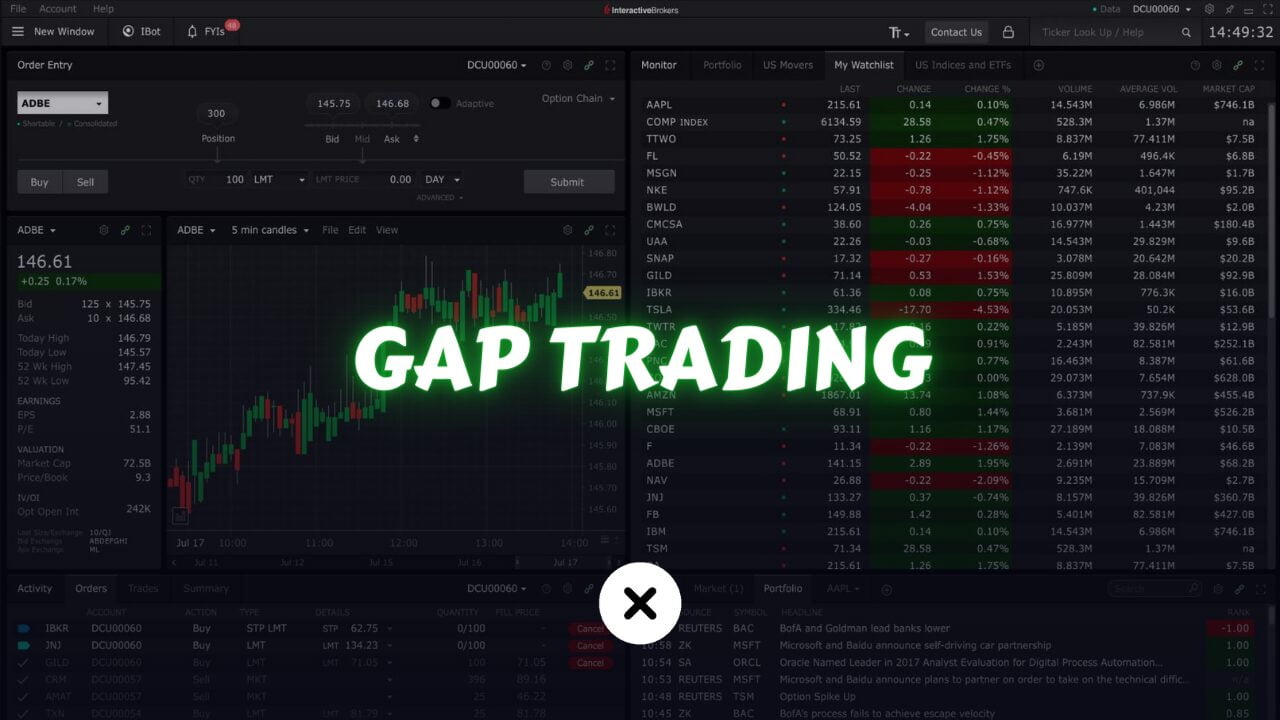
Gap trading strategy also known is OPG(Open Price Gap) is a popular trading strategy used in financial markets, especially in stocks. It involves exploiting the price gaps that occur when the market opens after a period of closure, such as overnight or over the weekend.
And it’s one of the best beginner friendly strategy for stock day trading.
What is Gap Trading?
You probably heard of “gap trading.” It’s quite popular among many traders. But what exactly is it?

A gap happens when a stock, which has been moving in a certain direction, suddenly opens at a different price level compared to its previous close. For instance, if a stock closed at $10 and then opens at, let’s say, $14 the next day, that creates what we call a gap.
The strategy behind gap trading is based on the belief that such gaps tend to get “filled.” This means that the stock price is expected to move back down to the previous level to “fill” the gap, in this case, back to $10.
There are two main possibilities here. Firstly, the stock could indeed move downwards, filling the gap entirely or even going lower. Alternatively, it might continue to rise without filling the gap.
So, the key question is whether the gap will be filled or not. Sometimes, even if there’s a gap, the stock might keep climbing without returning to fill it.
With that said, this strategy works for both going long and short. If something gaps up, you anticipate it to drop back down, so you short it. Likewise, if something gaps down and you expect it to rise, then you go long on it.
What we’re aiming to do is find stocks that have gapped and we anticipate will fill their gap. Now, why does this gap occur? To grasp that, we need to know how the opening price of a stock is calculated.
What is Opening Auction?
Before the market officially opens, exchanges begin collecting orders from traders who want to participate in the opening auction. Traders can submit two types of orders: Limit On Open (LOO) and Market On Open (MOO).
Traders use LOO orders to specify a price at which they are willing to buy or sell a stock when the market opens. These orders provide traders with control over the execution price of their trades, ensuring they get a favorable price.
MOO orders, on the other hand, instruct the exchange to execute the trade at the opening price, regardless of the exact price level. Traders who submit MOO orders are willing to accept whatever the opening price turns out to be, providing flexibility and immediacy in executing their trades.
Once all orders are collected, the exchange begins the auction matching process. It matches LOO and MOO orders based on price and volume.
The auction process aims to determine the opening price at which the maximum volume of orders can be executed. This ensures that the opening price reflects the collective supply and demand dynamics of the market, providing a fair and efficient starting point for trading.
It’s important to note that during the opening auction, there is only one price at which all orders are executed. This means that regardless of whether a trader submitted a LOO or MOO order, all orders are filled at the same opening price.
Once the opening price is determined, the exchange executes the matched orders at that price. Traders who submitted LOO orders at or better than the opening price get their orders filled, while MOO orders are executed at the opening price.
Throughout the auction process, market participants have visibility into the orders being submitted and the price levels at which trades are expected to occur.
And this is how the opening price of a stock is determined. and it is also the reason for the gaps to occur. If you want to learn more about opening auction, follow the link.
Logic Behind Gap Trading Strategy
Picture this: one day, there aren’t many sellers, but plenty of buyers are eager to join the auction. Yet, there are hardly any sellers around. What might happen next? The price could start at an extremely high level simply because there aren’t enough sellers to balance out the demand from buyers.
For instance, imagine a stock closed at $10 yesterday. But the next day, something unusual happens. There are plenty of buyers with Market On Open (MOO) orders, but very few sellers. The few sellers that are there are asking for prices like $16.
In this situation, the stock will open at $16 because there aren’t enough sellers at lower prices like $11 or $12. So, it opens really high due to this imbalance. When the stock opens, traders might think, “There’s no real reason for the stock to open this high, like good earnings or news. It’s just an imbalance.” So, they start shorting it, expecting it to drop back down and fill the gap. And this strategy often works because of the initial imbalance.
But here’s the thing: not all stock gaps get filled. If you screen all the stocks with gaps, most gaps don’t fill. The gaps that do fill are the ones caused by an imbalance in supply and demand at a specific point. It’s not because of any news or events; it’s just that on that day, there was either not a lot of supply or not a lot of demand, causing the price to open higher or lower.
So, how do we identify these stocks? We’ll learn about that in the next article. But you can see there’s a logic to it. If there’s news or something going on with the company causing the gap, it’s unlikely to fill. But if the gap happened for no reason and there’s nothing going on, chances are it will be filled eventually.
And this is what gap trading strategy is all about.
